The United Nations cultural agency, UNESCO, called Thursday for the protection and preservation of Afghanistan’s cultural heritage, warning that harming it could only have adverse consequences on lasting peace.
“Afghanistan is home to a wide range of rich and diverse heritage, which is an integral part of Afghan history and identity, as well as of importance for humanity as a whole, that must be safeguarded,” the agency said in a statement.
Experts are concerned about the National Museum in Kabul, as well as designated World Heritage sites, including the minaret and archaeological remains of Jam and the cultural landscape and archaeological remains of the Bamiyan Valley.
Twenty years ago, the Taliban blew up the two Buddhas of Bamiyan, mammoth statutes which had stood in niches carved into the valley’s mountains for centuries.
UNESCO has said their deliberate destruction was intended to destroy culture, identity and history and showed how destroying heritage could be used as a weapon against local populations.
Images of Taliban fighters blowing up the statues was broadcast around the world, raising awareness of the importance of persevering cultural heritage. In 2012, the international community recognized the intentional destruction of cultural heritage as a war crime.
On Tuesday, Karima Bennoune, the U.N. special rapporteur in the field of cultural rights, urged nations to act urgently to prevent “a massive human rights and cultural disaster” in Afghanistan.
“Protecting Afghan lives and rights must be the top priority,” she said. “Efforts must also be made to ensure the safety of all forms of culture and cultural heritage which are essential for enjoyment of those rights, and to protect those who defend it on the frontlines.”
The special rapporteur appealed to international cultural and educational institutions to invite Afghan artists, cultural workers and students, especially women and members of minority groups to their establishments to allow them to continue their work in safety.









